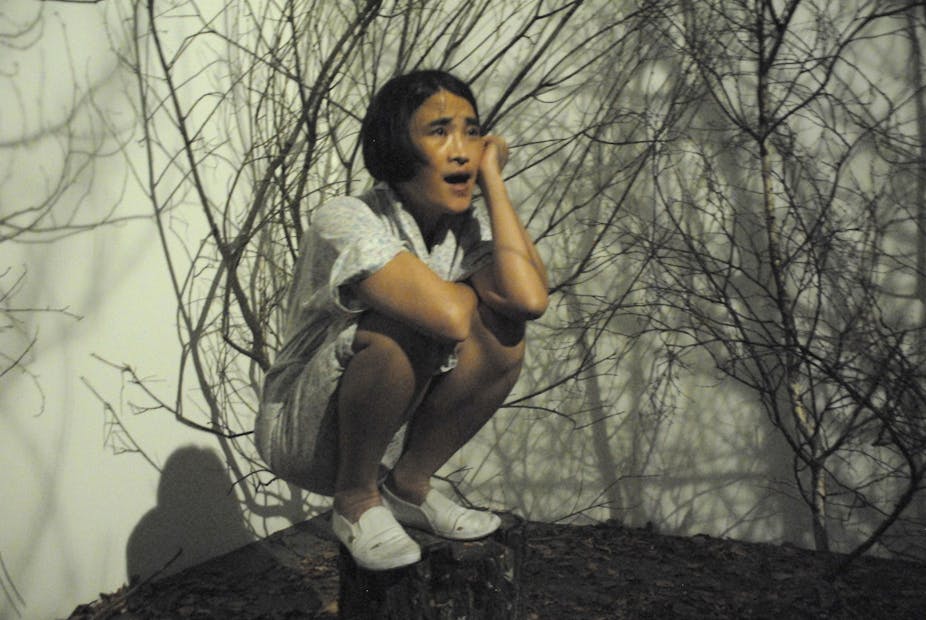Until the end of the 2014 Biennale of Sydney in June, Chinese performance artist Yingmei Duan will live in a small forest built inside the Art Gallery of NSW.
Visitors – as they have since the start of the Biennale – will have the chance to meet Duan and interact with her as she dispenses wishes and prophecies written on small pieces of paper.
And this is only the latest example of renewed interest in performance art that draws on the rich history of feminist art. Indeed, it’s part of a resurgence in performance art that looks a lot like a backlash against the ascendancy of the digital in the 21st century – and like a revitalisation of feminist concerns in contemporary art.
You may have been among the thousands who queued for hours to get a peek of public art project 13 Rooms at Sydney’s Pier 2/3 last year.
13 Rooms featured 13 live acts, many of which re-staged well-known works from the canon of performance art that were first performed decades ago. Free to the public, 13 Rooms was the latest international visual arts event promoted by arts philanthropist John Kaldor. It proved a resounding success, especially given the reputation of performance art as a “difficult” medium.
Despite the fact two of the main draw-cards, Belgrade-born performance artist Marina Abramovic and American video artist Joan Jonas, pioneered performance and video art driven by feminist concerns in the 1970s, we were not told about the contribution of feminism to the history of these vital contemporary media.
This blindness to feminism’s role in shaping the issues and approaches current in art practice today stretches beyond performance.
Questioning the hierarchies between high art and lowly craft; challenging the boundaries between disciplines; insisting on the centrality of the body and subjective experience in all social formations and ideas; highlighting the importance of social connections and working through community: these are some of the key themes of contemporary art that owe a debt to feminism.
The good news is that, even though institutions may have been failing to acknowledge feminist art practice, it is now well in the sights of a groundswell of Australian artists, writers and curators. Over the last couple of years, as debate about the status of women in Australian society has intensified online and elsewhere, initiatives devoted to re-claiming the tools and insights of feminism for the hard work of producing and analysing critical visual culture have grown rapidly.
In 2010, the artist-run feminist collective and gallery LEVEL was established in Brisbane, to “level the playing field”.
In 2012, A Dinner Party: setting the table, a collaborative series of events exploring feminist art, got off the ground in Melbourne. That same year, the Cruthers Collection of Women’s Art, the result of a major private bequest to the University of Western Australia, held its first major exhibition and symposium on the contribution of women artists to Australian life and culture, while the Gallery of Modern Art in Brisbane exhibited the all-woman show, Contemporary Australia: Women.
In Sydney, in the same period, The Performance Space staged Sexes, a month-long program of feminist and queer inspired work.
And last year, the Victorian College of the Arts (VCA) gallery shone the light on feminist humour, Sydney’s Artspace held a feminist art symposium and gave its galleries over to a pulsating installation by international feminist troupe Chicks on Speed.
Kelly Doley collaboratively curated two exhibitions as part of the broader feminist project Janis (named after the rock goddess). And all this time, artist Elvis Richardson’s Guerilla Girls inspired CoUNTess blog kept track of the statistics that demonstrate the devastating reality of gender inequality in the Australian art-world.
These projects are just the beginning of a long list.
Ranging from exhibitions to symposiums to long-running platforms for collaboration and research, they are instrumental to reclaiming the enormous impact of feminist ideas and practices on the visual arts, and to incubating the most vital contemporary art of the future.

